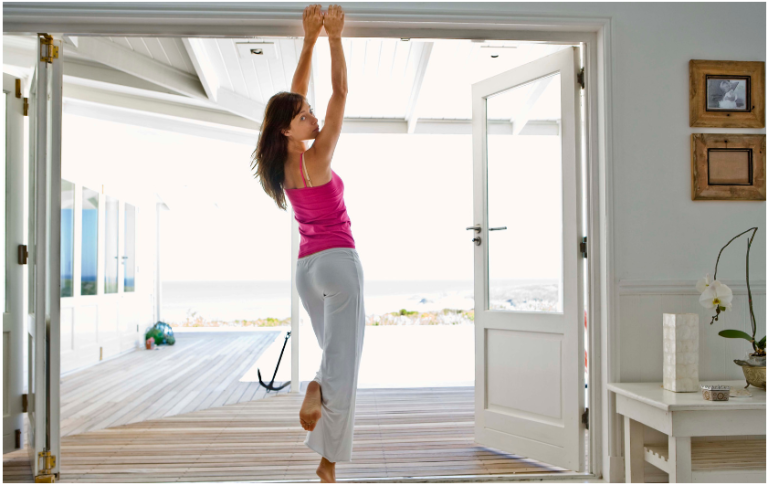
Does Stretching Release Endorphins?

Have you ever wondered why stretching feels so good? Whether you stretch in the morning, after a workout, or whenever you feel like it, you may notice a feeling of calmness and relaxation or even a feeling of euphoria. This is not just a coincidence.
Stretching releases endorphins, the natural chemicals that make you feel good. In this article, we will explore how and why stretching releases endorphins, the benefits of stretching for your physical and mental health, and how stretching helps reduce your risk of developing certain conditions. Read on to learn more about how stretching may help improve your physical and mental health through regular practice!
What are endorphins, and how do they work?

Endorphins are neurotransmitters, which are chemical messengers that transmit signals between nerve cells in the brain and the body. The pituitary gland and the hypothalamus produce endorphins, binding to opioid receptors, which are involved in pain perception and reward. Endorphins act as natural painkillers, reducing the sensation of pain and increasing the feeling of plea sure. Endorphins also help regulate mood, stress, anxiety, and depression.
Endorphins are released in response to various stimuli, such as exercise, laughter, sex, spicy food, music, and stretching. When you stretch, you stimulate the nerve endings in your muscles, which send signals to the brain to release endorphins, making stretching feel good because it activates these pleasure centres.
Stretching also increases blood flow to your muscles, which may enhance the delivery of endorphins to the opioid receptors. Stretching may also activate your parasympathetic nervous system, responsible for the relaxation response. This may lower your heart rate, blood pressure, and cortisol levels and increase your feeling of calmness and relaxation.
Why does stretching feel so good?
One of the main reasons why stretching feels so good is because it releases endorphins, as we have seen. Endorphins can make you feel happy, relaxed, and euphoric. They can also reduce pain and inflammation and improve your mood and well-being.
Stretching helps you feel good because it improves your posture, flexibility, range of motion, and circulation. Stretching can also reduce muscle tension, stiffness, and soreness and prevent injuries and cramps, making it good to stretch to maintain physical well-being. Stretching can also help you relax mentally, as it can reduce stress, anxiety, and depression and improve your focus and concentration, showing how stretching reduces mental discomfort.

What are the benefits of stretching?
Stretching has many benefits for physical and mental health; besides releasing endorphins, stretching reduces your risk of injury and improves your daily functional movements. Some of the benefits of stretching include:
- Proper posture and alignment can prevent back pain, neck pain, and headaches.
- Increasing your flexibility and range of motion can improve your performance, prevent injuries, and help improve your posture.
- Enhancing your blood flow and circulation can improve oxygen and nutrient delivery, removing waste products and toxins from your muscles.
- Reducing your muscle tension and tightness can improve your mobility and comfort.
- Preventing muscle atrophy and stiffness, which can occur due to ageing, a sedentary lifestyle, prolonged sitting, and regular stretching help mitigate these effects.
- Improving your balance and coordination can prevent falls and accidents.
- Boosting your immune system, which can help you fight infections and diseases.
- Improving your sleep quality can help you feel more rested and refreshed.
- Enhancing your mood and well-being can help you cope with stress, anxiety, and depression.
What are the types of stretching, and how do you do them?
There are different types of stretching that you can do, depending on your goals, preferences, and needs. Some of the common types of stretching are:
- Static stretching involves holding a stretch for a certain amount of time, usually 15 to 30 seconds. Static stretching is good for improving your flexibility and range of motion and relaxing your muscles. Static stretching is best done after a warm-up or at the end of your workout, as it can reduce your muscle power and performance if done before. Static stretching can also activate your parasympathetic nervous system, which can induce a feeling of calmness and relaxation.
- Dynamic stretching involves moving your joints and muscles through their full range of motion, usually in a rhythmic and controlled manner. Dynamic stretching is good for warming up your muscles and joints and preparing them for activity. Dynamic stretching can also improve your blood flow and circulation, increase your muscle temperature and elasticity, and is a good practice to help improve your overall mobility and function. Dynamic stretching is best done before your workout or activity, as it can improve your performance and prevent injuries. Dynamic stretching can also release endorphins, making you feel good and energized.
- Active stretching involves contracting the opposite muscle group of the one you are stretching to create tension and resistance. Active stretching is good for improving your strength and stability and activating your muscles. Active stretching can also increase blood flow and circulation, enhance endorphin release, and help improve your posture and muscle coordination. Active stretching can be done anytime, as it can help you maintain your muscle tone and function.
What are some tips for stretching?
Stretching can be a simple and effective way to release endorphins, feel good, and improve your physical and mental health. However, to get the most out of stretching, you should follow some tips, such as:
- Stretch regularly, ideally every day or at least three times a week. Stretching can help keep your muscles healthy and flexible and prevent them from becoming tight and stiff.
- Stretch gently and gradually, and avoid bouncing or jerking. Stretching should not cause pain or discomfort but rather a mild sensation of tension or resistance. If you feel any pain or discomfort, stop or ease off the stretch.
- Stretch both sides of your body, and balance your stretching routine. Stretching can help you correct any imbalances or asymmetries in your body and prevent injuries and pain. Make sure to stretch both sides of your body equally, and include all the major muscle groups in your stretching routine.
- Breathe deeply and relax while stretching. Stretching can help you relax your mind and body and release endorphins. However, to achieve this, you must breathe deeply and calmly and avoid holding your breath or tensing up. Breathing can also help you increase your stretch and range of motion, as it can relax your muscles and joints.
- Listen to your body and adjust your stretching accordingly. Stretching can be different for everyone, depending on your age, fitness level, health condition, and goals, but regularly stretching helps improve your overall function and well-being. Therefore, you should listen to your body and adjust your stretching accordingly. Stretch according to your needs and preferences, and avoid stretching if you have any injuries, inflammation, or contraindications.
Summary and conclusion
Stretching is an open secret; stretching is generally good for us but can also make you feel good. Stretching releases endorphins, the natural chemicals that make you feel happy, relaxed, and euphoric. Stretching also has many physical and mental benefits, such as improving your posture, flexibility, range of motion, circulation, muscle tension, sleep quality, mood, and well-being.
Stretching can be done in different ways, such as static, dynamic, and active stretching, depending on your goals, preferences, and needs. Stretching can also be done anytime, anywhere, and by anyone, as long as you follow some tips, such as stretching regularly, gently, on both sides, breathing, and listening to your body, which helps improve your flexibility and mental state.
Stretching can be a simple and effective way to release endorphins, feel good, and improve your health and performance. So, what are you waiting for? Start stretching today and enjoy the benefits!
Frequently Asked Questions
Q: Do I need to feel pain or discomfort to release endorphins from stretching?
A: No, you don’t! You can enjoy the benefits of endorphins from stretching even if you don’t feel any pain or discomfort. Stretching sends signals to your brain that trigger the release of endorphins, making you feel good and happy.
Q: How long will I feel the effects of endorphins from stretching?
A: It depends on the person. Some people may feel a temporary mood lift, while others may feel the effects for longer. Stretching regularly can help you keep a steady level of endorphins and improve your well-being.
Q: Can stretching help me with depression?
A: Stretching can boost your mood and well-being, but it should not be the only treatment for depression. You should always seek professional help for depression. However, stretching can be part of a holistic self-care plan that supports your mental health.
Q: Are some stretches better than others for releasing endorphins?
A: All stretches can help you release endorphins. But you may find that dynamic stretches that move your muscles through a full range of motion are especially effective in stimulating the release of endorphins.
Q: Should I stretch before a workout to get more endorphins?
A: Yes, you should! Stretching before a workout can help you get ready for exercise and increase your endorphin levels. Stretching can warm up your muscles, improve your blood circulation, and set you in a positive mood, making your workout more fun and rewarding.
Q: Will stretching help me sleep better?
A: Yes, it will! Stretching can help you sleep better by relaxing your body and mind. The stress-relieving and calming effects of stretching can help you unwind and get ready for a good night’s sleep. Stretching before bed can help you improve your sleep quality and well-being.



